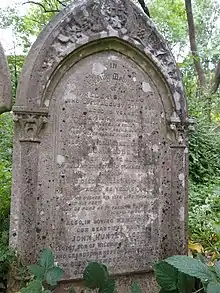John Lobb
John Lobb founded the company John Lobb Bootmaker.
Early life
John Lobb was born in Tywardreath, near Fowey, Cornwall on the 27th December 1829. Unable to follow his father's farmwork occupation after an accident left him with a lifelong limp, John served a five year apprenticeship with a local shoemaker. Seeking a greater stage for his skills, he walked the almost 250 miles (400 km) to St James's in London, in a stout pair of boots of his own making, only to be ejected from the premises of the best-known society bootmaker, when he demanded to see the proprietor, Mr Thomas.[1]
Sydney
The talk of London at the time was of the Australian gold strikes, so Lobb booked the first available passage to Sydney, New South Wales. True to the maxim that those who supply gold miners make more money than the miners themselves, as the only shoemaker amongst the prospectors, Lobb prospered making sturdy boots with secret compartments for gold particles in the hollow heels[2] and with his earnings he opened a shop in George Street, Sydney which also flourished.[1]
In 1857 he married Caroline Victoria, daughter of Thomas Richards, the Sydney harbourmaster and she gave birth to three children in Sydney, John, born in 1858, Caroline Victoria in 1859 and Mary Aline in 1861. Lobb's first apprentice, in 1863, was his wife's younger brother, Frederick Moses Richards (c.1849–1907), who later became the mainstay of the firm.
In spite of his success in Australia, Lobb wanted to manufacture for London society so he exhibited his footwear at the 1862 International Exhibition, winning the sole gold medal awarded to an Australian entry. He followed this coup by speculatively making a fine pair of riding boots for the Prince of Wales which he had delivered with a request to be appointed bootmaker to the prince. Remarkably this bold approach was successful and a royal warrant was issued on the 12th October 1863, whereupon he sold his Sydney shop, took passage to England with his apprentice Frederick, temporarily leaving his wife and children in Sydney.[1]

London
Following the opening of his London premises at 296 Regent Street in 1866 his family joined him and three more children were born, William Hunter Lobb in 1870, Frederick Lobb in 1871, and a daughter who died in infancy. However his wife subsequently left him and moved to Paris where she later died. If Lobb was downhearted it didn't last long, for he soon gained a reputation as a man about town and bon viveur, returning often to his Cornish village and becoming a local philanthropist. The business prospered, winning medals at international exhibitions and opening a second shop, at 29 St James's Street, near that of Thomas, from which he had been ejected so many years before.[1]
Children
John Lobb junior was banished from the family by his father for dishonesty, married a chorus girl and retired to Margate, where he was discreetly supported by his brother. In later years he and his wife were much loved and visited by the Lobb children. William Hunter Lobb (1870–1916) trained as a bootmaker, oversaw the expanding business, opening a shop in Paris in 1901 and a second premises in Regent Street in 1904. He married Betsy Smerdon (1868–1956), the daughter a Devon farmer.[1]
Later life
John Lobb died at 296 Regent Street, still firmly in command of his business, on the 17 January 1895 and is buried at Highgate Cemetery (east side).
References
- McConnell, Anita (23 September 2004). "Lobb, John". Oxford Dictionary of National Biography (online ed.). Oxford University Press. doi:10.1093/ref:odnb/61386. (Subscription or UK public library membership required.)
- "Shoes for the Famous". British Pathé. Retrieved 2 Feb 2021.
Further reading
- Brian Dobbs (1972). The Last Shall Be First: The Colourful Story of John Lobb The St. James's Bootmakers. Elm Tree Books. ISBN 0241022738.
- Nicholas Storey (2008). History of Men's Fashion: What the Well-dressed Man is Wearing. Casemate Publishers. ISBN 978-1-84468-037-5.